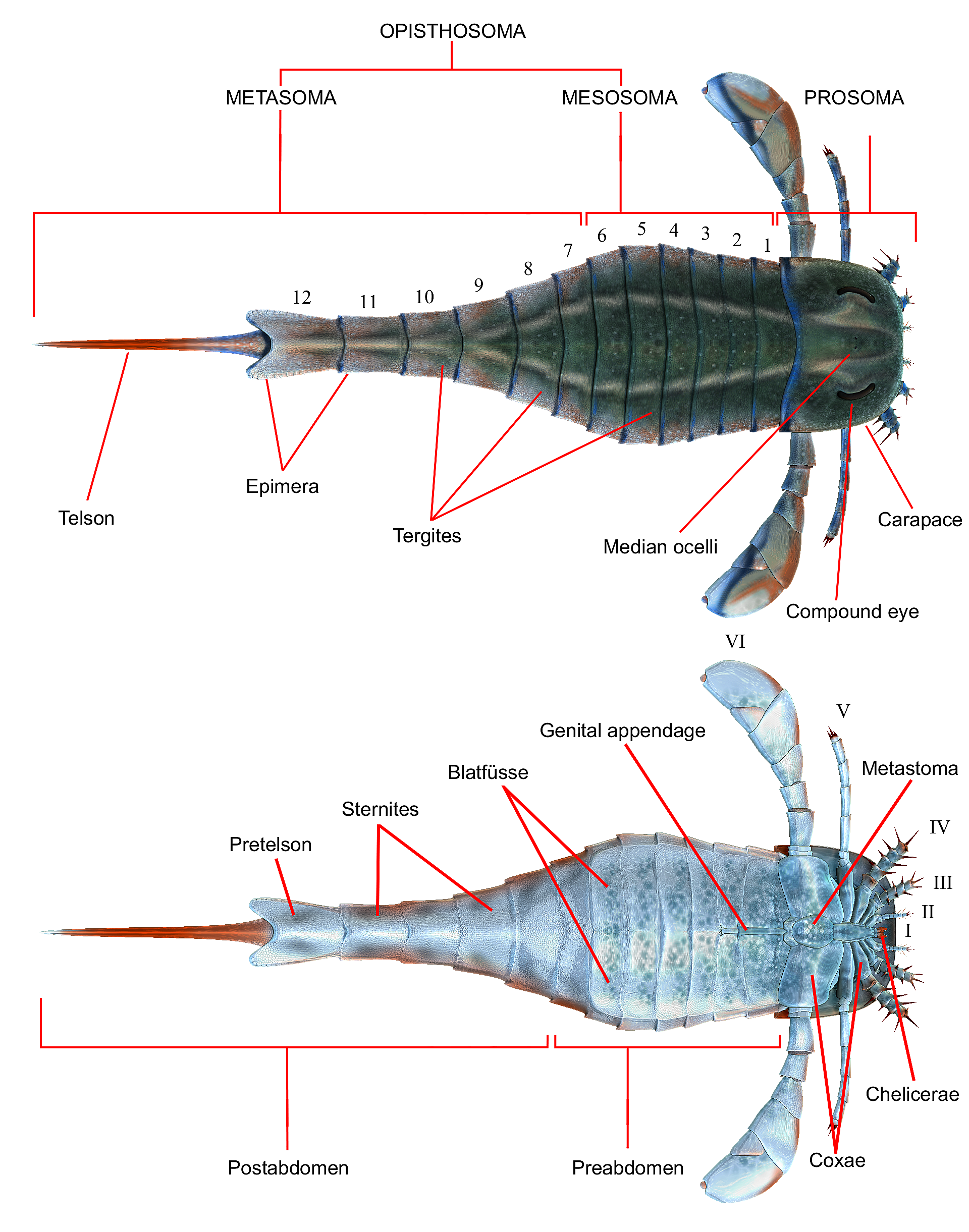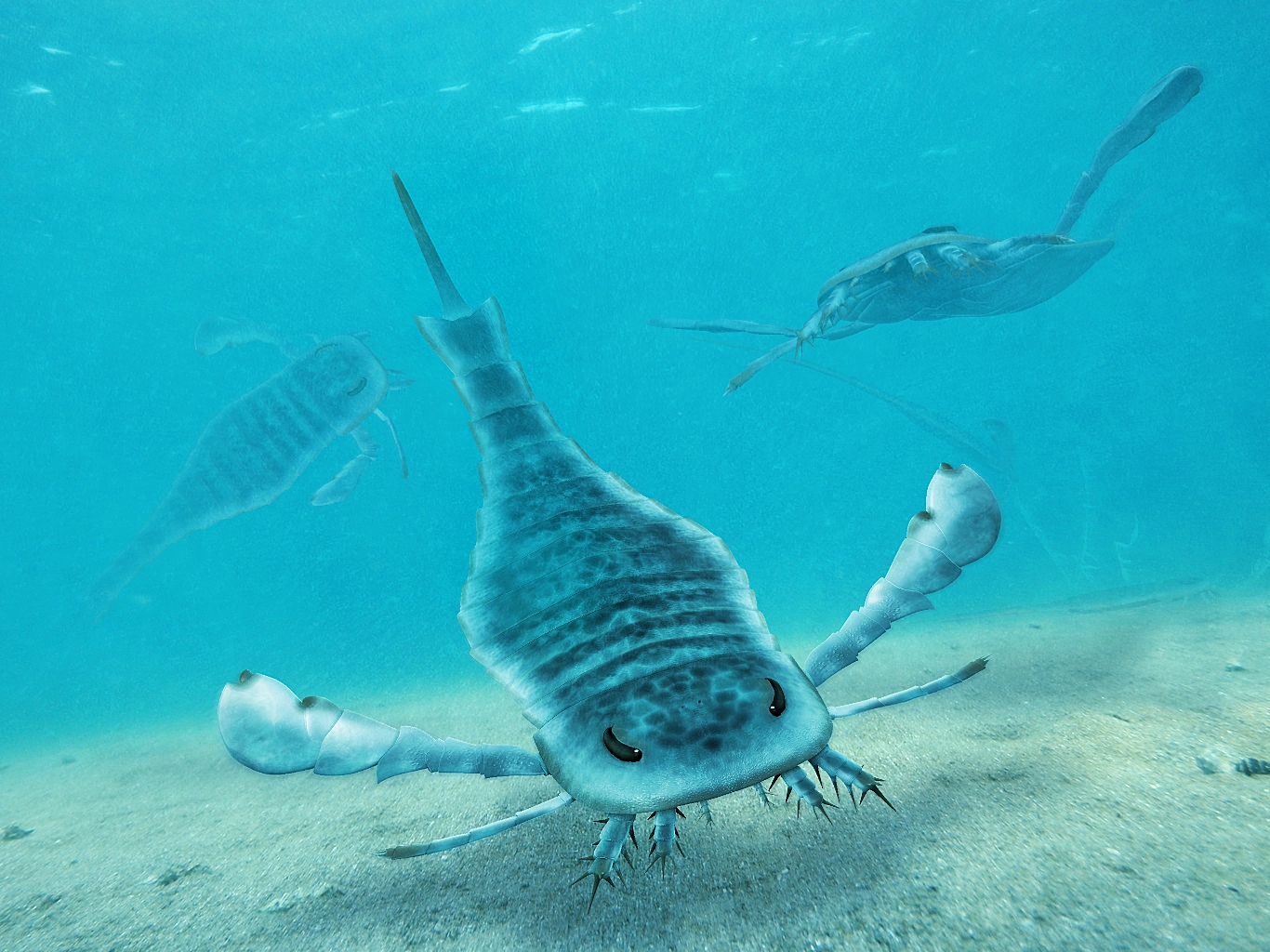|
Adelophthalmidae
Adelophthalmidae (the name deriving from the type genus ''Adelophthalmus'', meaning "no obvious eyes") is a family of eurypterids, an extinct group of aquatic arthropods. Adelophthalmidae is the only family classified as part of the superfamily Adelophthalmoidea, which in turn is classified within the infraorder Diploperculata in the suborder Eurypterina. Adelophthalmid eurypterids were small and swimming eurypterids that appeared in the Silurian period. With the earliest known members of the group, '' Nanahughmilleria prominens'' and '' Parahughmilleria maria'', being known from deposits of Early Silurian (possibly the Llandovery epoch) age and the last members, belonging to the long-lasting and widespread genus ''Adelophthalmus'', going extinct in the Early Permian, the Adelophthalmidae is the longest lasting single family of eurypterids. The survival of the group, and of swimming eurypterids (the suborder Eurypterina) beyond the Late Devonian is entirely due to the survival, a ... [...More Info...] [...Related Items...] OR: [Wikipedia] [Google] [Baidu] |
Unionopterus
''Unionopterus'' is a genus of eurypterid, an extinct group of aquatic arthropods commonly known as "sea scorpions". Fossils have been registered from the Early Carboniferous period. The genus contains only one species, ''U. anastasiae'', recovered from deposits of Tournaisian to Viséan stages in Kazakhstan. Known from one single specimen (now presumed to be lost) which was described in a publication of Russian language with poor illustrations, ''Unionopterus'' affinities are extremely poorly known. ''Unionopterus'' was described in 1948 after the discovery of its only known specimen in the Karaganda Formation of Kazakhstan (at that time part of the Soviet Union). This was one of the first discoveries of eurypterids in the Soviet Union and Carboniferous eurypterids in general. It was probably a swimming organism as well as other eurypterids, although not as good as its relatives. There are numerous factors that have made ''Unionopterus'' a problematic genus for eurypterid r ... [...More Info...] [...Related Items...] OR: [Wikipedia] [Google] [Baidu] |
Eurypterid
Eurypterids, often informally called sea scorpions, are a group of extinct arthropods that form the Order (biology), order Eurypterida. The earliest known eurypterids date to the Darriwilian stage of the Ordovician period 467.3 Myr, million years ago. The group is likely to have appeared first either during the Early Ordovician or Late Cambrian period. With approximately 250 species, the Eurypterida is the most diverse Paleozoic Chelicerata, chelicerate order. Following their appearance during the Ordovician, eurypterids became major components of marine faunas during the Silurian, from which the majority of eurypterid species have been described. The Silurian genus ''Eurypterus'' accounts for more than 90% of all known eurypterid specimens. Though the group continued to diversify during the subsequent Devonian period, the eurypterids were heavily affected by the Late Devonian extinction event. They declined in numbers and diversity until becoming extinct during the Permian–Tri ... [...More Info...] [...Related Items...] OR: [Wikipedia] [Google] [Baidu] |
Adelophthalmus
''Adelophthalmus'' is a genus of eurypterid, an extinct group of aquatic arthropods. Fossils of ''Adelophthalmus'' have been discovered in deposits ranging in age from the Early Devonian to the Early Permian, which makes it the longest lived of all known eurypterid genera, with a total temporal range of over 120 million years. ''Adelopththalmus'' was the final genus of the Eurypterina suborder of eurypterids and consisted the only known genus of swimming eurypterids from the Middle Devonian until its extinction during the Permian, after which the few surviving eurypterids were all walking forms of the suborder Stylonurina. Fossils of ''Adelophthalmus'' have been described from four continents; North America, Europe, Asia and Australia, which indicates that ''Adelophthalmus'' might have had a nearly cosmopolitan (worldwide) distribution, one of few eurypterid genera to achieve one besides potentially ''Pterygotus''. The territorial expansion of ''Adelophthalmus'' had begun early, ... [...More Info...] [...Related Items...] OR: [Wikipedia] [Google] [Baidu] |
Bassipterus
''Bassipterus'' ("wing from Bass") is a genus of eurypterid, an extinct group of aquatic arthropods. ''Bassipterus'' is classified as part of the family Adelophthalmidae, the only clade within the derived ("advanced") Adelophthalmoidea superfamily of eurypterids. Fossils of the single and type species, ''B. virgnicus'', have been discovered in deposits of the Late Silurian age in West Virginia and Maryland, United States. The genus is named after Bass, where most of the fossils have been recovered. ''Bassipterus'' was a well-known basal ("primitive") genus that was distinguished from the more derived adelophthalmids by the specialization of its genital operculum (a plate-like segment which contains the genital aperture) and its long and narrow eyes, being '' Pittsfordipterus''s closest relative. Description ''Bassipterus'' is almost completely known, with the first to fifth pair of limbs and type B genital appendage being the only unknown body parts. The body had a lanceola ... [...More Info...] [...Related Items...] OR: [Wikipedia] [Google] [Baidu] |
Nanahughmilleria
''Nanahughmilleria'' ("dwarf ''Hughmilleria''") is a genus of eurypterid, an extinct group of aquatic arthropods. Fossils of ''Nanahughmilleria'' have been discovered in deposits of Devonian and Silurian age in the United States, Norway, Russia, England and Scotland, and have been referred to several different species. ''Nanahughmilleria'' is classified in the family Adelophthalmidae, the only clade in the superfamily Adelophthalmoidea. This clade was characterised by their small size, their parabolic (approximately U-shaped) carapaces and the presence of epimera (lateral "extensions" of the segment) on the seventh segment, among others. ''Nanahughmilleria'' was different from its relatives by the presence of more spines in its appendages (limbs) and by its genital morphology. The largest species confidently assigned to the genus was ''N. norvegica'' at 10 cm (3.9 in), making it a comparatively small eurypterid. Description Like the other adelophthalmid eurypterids, ''Nanahug ... [...More Info...] [...Related Items...] OR: [Wikipedia] [Google] [Baidu] |
Parahughmilleria
''Parahughmilleria'' (meaning "near ''Hughmilleria''"Meaning opara-at ''www.dictionary.com''. Retrieved 17 July 2018.) is a genus of eurypterid, an extinct group of aquatic arthropods. Fossils of ''Parahughmilleria'' have been discovered in deposits of the Devonian and Silurian age in the United States, Canada, Russia, Germany, Luxembourg and Great Britain, and have been referred to several different species. The first fossils of ''Parahughmilleria'', discovered in the Shawangunk Mountains in 1907, were initially assigned to ''Eurypterus''. It would not be until 54 years later when ''Parahughmilleria'' would be described. ''Parahughmilleria'' is classified in the family Adelophthalmidae, the only clade in the superfamily Adelophthalmoidea. This clade was characterised by their small size, their parabolic (approximately U-shaped) carapaces and the presence of epimera (lateral "extensions" of the segment) on the seventh segment, among others. Like its relatives, ''Parahughmilleri ... [...More Info...] [...Related Items...] OR: [Wikipedia] [Google] [Baidu] |
Eysyslopterus
''Eysyslopterus'' is a genus of eurypterid, an extinct group of aquatic arthropods. ''Eysyslopterus'' is classified as part of the family Adelophthalmidae, the only clade within the derived ("advanced") Adelophthalmoidea superfamily of eurypterids. One fossil of the single and type species, ''E. patteni'', has been discovered in deposits of the Late Silurian period ( Ludlow epoch) in Saaremaa, Estonia. The genus is named after ''Eysysla'', the Viking name for Saaremaa, and ''opterus'', a traditional suffix for the eurypterid genera, meaning "wing". The species name honors William Patten, an American biologist and zoologist who discovered the only known fossil of ''Eysyslopterus''. ''Eysyslopterus'' is a little-known basal genus that was distinguished from the rest of adelophthalmids by the position near the head margin of the eyes, different from the rest of its relatives. Its carapace was parabolic (approximately U-shaped) and with transverse deep furrows forming the orna ... [...More Info...] [...Related Items...] OR: [Wikipedia] [Google] [Baidu] |
Pittsfordipterus
''Pittsfordipterus'' ("wing from Pittsford") is a genus of eurypterid, an extinct group of aquatic arthropods. ''Pittsfordipterus'' is classified as part of the family Adelophthalmidae, the only clade in the derived ("advanced") Adelophthalmoidea superfamily of eurypterids. Fossils of the single and type species, ''P. phelpsae'', have been discovered in deposits of Silurian age in Pittsford, New York state. The genus is named after Pittsford, where the two only known specimens have been found. ''Pittsfordipterus'' was a basal ("primitive") genus that was distinguished from the more derived adelophthalmids by the specialization of its genital operculum (a plate-like segment which contains the genital aperture) and its long and narrow eyes, being ''Bassipterus'' closest relative. With an estimated length of 6 cm (2.4 in), ''Pittsfordipterus'' was one of the smallest adelophthalmids. Description Like the other adelophthalmid eurypterids, ''Pittsfordipterus'' was a small eury ... [...More Info...] [...Related Items...] OR: [Wikipedia] [Google] [Baidu] |
Pruemopterus
''Pruemopterus'' is a genus of eurypterid, an extinct group of aquatic arthropods. The type and only species of ''Pruemopterus'', ''P. salgadoi'', is known only from a single fossil specimen, discovered in deposits of Early Devonian age in Germany. The generic name is derived from the Prüm river and the surrounding Prüm valley, which contains the finding place of the fossil, and the Greek πτερόν (pteron, "wing"), referring to the eurypterid swimming paddles, and the species name honors the Brazilian photographer and photojournalist Sebastião Salgado. ''Pruemopterus'' was a very small adelophthalmid eurypterid, with the type and only known specimen only measuring about 2.5 centimeters (0.98 in) in length. Although superficially similar to the related genus ''Parahughmilleria'', ''Pruemopterus'' can be distinguished from other adelophthalmids by several features, most notably its wide and vaguely rectangular carapace (head plate) and its rounded, rather than elongate ... [...More Info...] [...Related Items...] OR: [Wikipedia] [Google] [Baidu] |
Eurypterina
Eurypterina is one of two suborders of eurypterids, an extinct group of chelicerate arthropods commonly known as "sea scorpions". Eurypterine eurypterids are sometimes informally known as "swimming eurypterids". They are known from fossil deposits worldwide, though primarily in North America and Europe. Seventy-five percent of eurypterid species are eurypterines; this represents 99% of specimens. The superfamily Pterygotioidea is the most species-rich clade, with 56 species, followed by the Adelophthalmoidea with 43 species; as sister taxa, they comprise the most derived eurypterines. Pterygotioidea includes the pterygotids, which are the only eurypterids known to have a cosmopolitan distribution. Though more numerous both in specimens and taxa, the eurypterines have the shorter temporal range of the two eurypterid suborders. They first appeared around the same time as the Stylonurina in the Middle Ordovician. The suborder faced a slow extinction during the Middle and Late Devo ... [...More Info...] [...Related Items...] OR: [Wikipedia] [Google] [Baidu] |
Silurian
The Silurian ( ) is a geologic period and system spanning 24.6 million years from the end of the Ordovician Period, at million years ago ( Mya), to the beginning of the Devonian Period, Mya. The Silurian is the shortest period of the Paleozoic Era. As with other geologic periods, the rock beds that define the period's start and end are well identified, but the exact dates are uncertain by a few million years. The base of the Silurian is set at a series of major Ordovician–Silurian extinction events when up to 60% of marine genera were wiped out. One important event in this period was the initial establishment of terrestrial life in what is known as the Silurian-Devonian Terrestrial Revolution: vascular plants emerged from more primitive land plants, dikaryan fungi started expanding and diversifying along with glomeromycotan fungi, and three groups of arthropods (myriapods, arachnids and hexapods) became fully terrestrialized. A significant evolutionary milestone during ... [...More Info...] [...Related Items...] OR: [Wikipedia] [Google] [Baidu] |
Geological Period
The geologic time scale, or geological time scale, (GTS) is a representation of time based on the rock record of Earth. It is a system of chronological dating that uses chronostratigraphy (the process of relating strata to time) and geochronology (scientific branch of geology that aims to determine the age of rocks). It is used primarily by Earth scientists (including geologists, paleontologists, geophysicists, geochemists, and paleoclimatologists) to describe the timing and relationships of events in geologic history. The time scale has been developed through the study of rock layers and the observation of their relationships and identifying features such as lithologies, paleomagnetic properties, and fossils. The definition of standardized international units of geologic time is the responsibility of the International Commission on Stratigraphy (ICS), a constituent body of the International Union of Geological Sciences (IUGS), whose primary objective is to precisely define gl ... [...More Info...] [...Related Items...] OR: [Wikipedia] [Google] [Baidu] |







